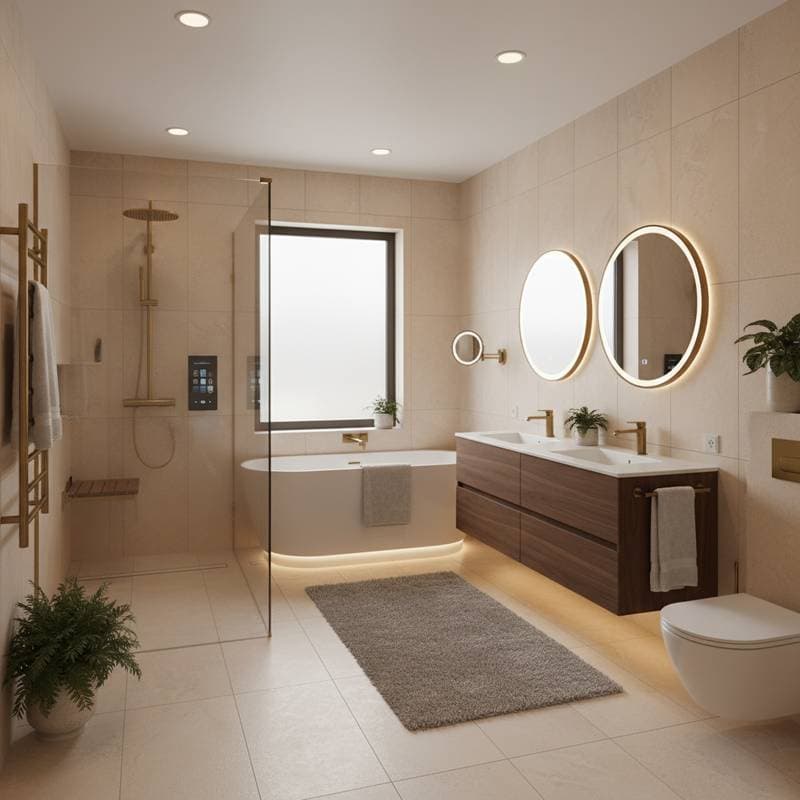Biophilic Bathrooms: Nature-Inspired Spa Retreats
Imagine stepping into your bathroom and feeling transported to a peaceful forest haven. Biophilic design achieves this by incorporating elements of nature that promote calm and connection. Bathrooms suit this approach well, as they already involve water, light, and renewal, which align with natural themes. You can create a spa-like space that enhances mood, supports wellness, and turns routine tasks into refreshing experiences, regardless of your budget.
Benefits of Biophilic Design in Bathrooms
Bathrooms serve as spaces for restoration, and biophilic elements strengthen this purpose. This design incorporates plants, organic materials, natural light, and outdoor-inspired textures. Research indicates that such environments lower stress levels, support mental health, and promote restful sleep. The result combines aesthetic appeal with practical benefits for daily well-being.
Incorporating Greenery Effectively
Plants introduce vitality and freshness to any bathroom, even in areas with limited natural light. Select varieties that match your space and maintenance preferences for lasting impact.
- Budget-friendly selections: Choose resilient plants such as pothos or snake plants, which adapt to low-light conditions and cost less than $10 at local nurseries. Place them on shelves or windowsills to add immediate greenery.
- Moderate investments: Install vertical gardens or hanging planters to optimize space. These options, often under $100, create layered vegetation without cluttering surfaces.
- Premium installations: Opt for automated living walls with irrigation systems. These features, though more expensive, deliver a dramatic, immersive effect that mimics a natural cascade.
From professional design experience, incorporating twice as many plants as initially planned enhances the immersive quality, making the space feel more like an outdoor retreat.
Selecting Natural Materials
Materials play a crucial role in transforming bathroom ambiance. Introduce elements that evoke the outdoors to create depth and warmth.
- Affordable updates: Replace synthetic items with bamboo organizers, woven baskets, or stone accessories. These changes, available for under $20 each, shift the atmosphere toward natural serenity.
- Mid-level enhancements: Incorporate wooden shelves, teak benches, or stone basins. These durable additions provide both visual appeal and functionality for years.
- Luxury features: Use marble cladding, terrazzo flooring, or reclaimed wood panels. Such materials add sophistication and reflect light in ways that enrich the overall design.
Experience shows that natural materials interact with light to create dimension, much like in professional settings where they enhance visual interest and perceived quality.
Enhancing Light and Water Elements
Light and water form the core of spa experiences, so integrate them thoughtfully to elevate your bathroom.
- Simple adjustments: Position mirrors to reflect available light, or use dimmable fixtures to simulate daylight in windowless rooms. These no-cost or low-cost tweaks brighten and expand the space.
- Accessible improvements: Upgrade to rainfall showerheads or versatile sprayers, often found for under $50. They transform standard showers into invigorating, nature-like experiences.
- Advanced additions: Add skylights over bathing areas or place tubs near windows. These elements allow natural views and light, turning baths into contemplative sessions.
Adding Texture and Sensory Elements
Nature involves varied textures, so include them to make your bathroom more engaging and alive. Focus on touch, scent, and sound for a multi-sensory approach.
- Select pebble mats that provide subtle foot stimulation.
- Choose towels in neutral tones made from organic fabrics.
- Introduce diffusers with essential oils such as eucalyptus or lavender to evoke spa aromas.
- Incorporate audio elements, like speakers playing gentle nature sounds, to turn routines into mindful practices.
These details create layers that engage the senses and promote relaxation.
Adapting to Different Budgets
Biophilic design remains accessible across financial levels, allowing gradual implementation.
- Minimal spending: Gather natural stones for decorative displays, propagate plants in recycled containers, or paint walls in subtle earth tones. These steps require little investment yet yield noticeable calm.
- Moderate budgets: Combine plants with wooden storage and updated fixtures, plus textured linens. This approach builds a cohesive retreat without major renovations.
- Substantial investments: Pursue full remodels with stone surfaces, integrated lighting, and custom plant features. The outcome delivers comprehensive wellness benefits.
Each tier contributes to reduced stress and improved daily experiences.
Wellness and Mental Health Advantages
Beyond aesthetics, biophilic bathrooms support emotional well-being. Natural surroundings help alleviate anxiety, stabilize moods, and foster tranquility. Transforming this space creates an ongoing wellness ritual. Professional projects demonstrate how clients respond positively, often reporting greater peace in their routines. The design influences not only appearance but also how you approach each day.
Getting Started
Approach biophilic design as an opportunity to craft a personal sanctuary. Begin with one element, such as a plant or natural accessory, and expand as you notice the benefits. This method suits any budget and turns ordinary spaces into sources of renewal. You can achieve meaningful changes that enhance life quality, starting today.










